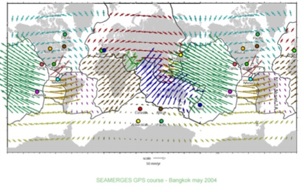Each Terrestrial Laser Scanning (TLS) position provides a point cloud. In the first instance the raw point clouds are in the coordinate system defined by the laser scanner itself. Adjacent scans are planned to overlap and the points lying within the overlapped area are used to stitch the individual scans together while minimizing the root mean square (RMS) error of the residual distances involved for the points lying within the overlap zone. This method used alone causes discontinuity from the inevitable accumulation of errors in the tie point positions.
Alternatively, a unified point cloud can be achieved using control points whose coordinates guide the registration of the adjacent point clouds. Typically this approach of transforming the raw point clouds into a unified coordinate system uses scanned targets in a local coordinate system to solve the transformation parameters. Using this information the point cloud can be moved from the scanner’s own coordinate system into a local coordinate system. The justification for this approach is the idea that a local coordinate system is sufficient and reference to a real-world, i.e. geodetic, coordinate system is not needed for most (if not all) terrestrial LiDAR applications. In my opinion this idea is short-sighted.
An independent local coordinate systemis created by bringing a flat plane tangent to the earth. The work is then projected directly onto the flat plane. The projection is based on the idea that a small section of the earth conforms so nearly to a plane that distortion is negligible. The approach has merit as long as the extent of the work is small, but the larger each of the planes grow the more untenable it becomes because the actual shape of the earth intrudes.
However, there is another problem with this approach. These local coordinate systems cannot be joined together without additional work to create a common reference. This common reference is easily available today from GNSS and can be very conveniently applied in the first instance.
Without a common reference the task of joining together a mosaic of individual local systems is exacerbated by the differences in the orientation of the axes, scale, and rotation of each one of the individual local systems involved. Since the elements of each local coordinate system are unlike those of its neighbors there are unresolvable gaps and overlaps between them. As long as there is no need to venture outside the bounds of a particular local system it is adequate but as the area of interest grows and other local systems are involved the situation becomes untenable. Today it is extraordinarily convenient to assign absolute positions to the unified point cloud. Given this it is much better if the coordinates of the control points used to register adjacent point clouds are known in a real-world, i.e. geodetic, coordinate system. If one simply uses targets whose coordinates are in such a real-world coordinate system the results will be much more useful than those expressed in local coordinate systems






